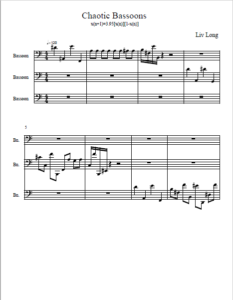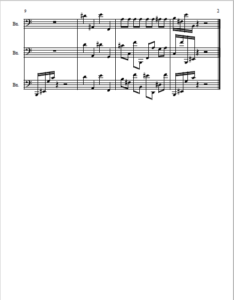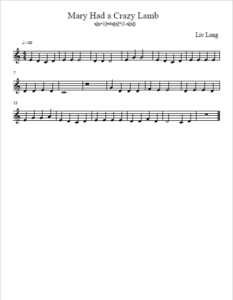Chaos theory appears to be a random collection of points and lines; however, it is completely the opposite. Chaotic functions are nonlinear functions that are practically impossible to predict (Fractal Foundation Chaos Theory). This leads to graphs and figures that are disjointed and as such they are given the name chaotic.
Background:
The main difference between chaos and randomness is the deterministic factor of chaos. This means that the system has order even if it is difficult to see. Chaotic systems are recursive meaning that each data point was found by using the point value before it. These connections are rarely obvious and that is why people assume that these points were created from randomness (Liebovitch 118). Chaotic equations are interesting because they are sporadic, and they are greatly affected by seemingly minute differences. Some of these small changes happen when different values are used as the first value of a function, also called initial conditions. Initial conditions are a large part of this because one of the definitions of chaos is that, “if a system is rerun with almost the same starting conditions, the values of the variables measured at the same time of the two runs separate from each other exponentially fast as a function of time” (Liebovitch 168). This explains why when initial conditions are off by small amounts, the end result is different from the original by a noticeable amount. Many chaotic equations are shown side by side with other cases that have nearly identical initial conditions, because this shows the extent of the chaos. The most famous chaotic idea is the butterfly effect which states that if a butterfly flaps its wings on one side of the world it will affect if a tornado occurs or not somewhere else in the world (Chaos 2019). The butterfly flapping its wings is the initial condition and the tornado or lack thereof is the exponentially different result that can occur from this scenario. Thus that one small difference of the butterfly’s wings changed the recursive relationship of the Earth’s climate to create a tornado or not.
The equation x(n+1)=3.95[x(n)][1-x(n)] is chaotic because it is deterministic, as can be seen by the multiplication of the previous term in the equation. The equation begins by an arbitrary choice of a starting point. The table shows the equation with three different starting values: 0.892, 0.893, and 0.894. The table shows the journey of the equation with all three of the different initial conditions.
| x(1) | 0.892 | 0.893 | 0.894 |
| x(2) | 0.380 | 0.360 | 0.374 |
| x(3) | 0.931 | 0.910 | 0.925 |
| x(4) | 0.253 | 0.324 | 0.274 |
| x(5) | 0.747 | 0.865 | 0.786 |
| x(6) | 0.746 | 0.461 | 0.664 |
| x(7) | 0.748 | 0.981 | 0.881 |
| x(8) | 0.745 | 0.074 | 0.414 |
| x(9) | 0.750 | 0.271 | 0.958 |
| x(10) | 0.741 | 0.780 | 0.159 |
| x(11) | 0.758 | 0.678 | 0.528 |
| x(12) | 0.725 | 0.862 | 0.984 |
| x(13) | 0.788 | 0.470 | 0.062 |
| x(14) | 0.660 | 0.984 | 0.230 |
| x(15) | 0.886 | 0.062 | 0.700 |
| x(16) | 0.399 | 0.230 | 0.830 |
*Equation and first column of values began in Liebovitch’s book
These initial conditions differ by 0.001 and they all follow the same pattern, but they take off in very different directions and end at points that differ by at least 0.169. The musical piece created from these values shows these situations by each number being associated with a note on the staff. Lower values correspond to lower notes and vice versa. It is possible to follow along with the piece by using the table. The music plays each column individually and then all three columns are played at the same time to help give perspective on the differences between the situations.
Played by Liv Long
The equation x(n+1)=4 [x(n)][1-x(n)] is chaotic because the values are deterministic. When x[0]=0.4, the following table emerges:
| x[1] | 0.9600 |
| x[2] | 0.1536 |
| x[3] | 0.5200 |
| x[4] | 0.9984 |
| x[5] | 0.0064 |
| x[6] | 0.0254 |
| x[7] | 0.0990 |
| x[8] | 0.3568 |
| x[9] | 0.9180 |
| x[10] | 0.3011 |
| x[11] | 0.8418 |
These values can then be applied to a song such as “Mary had a Little Lamb” by taking the total number of beats (32) and multiplying by the percentages given in the table and rounding to whole beats to select the notes. For each of these products that were found, the selected note was raised by one pitch (one note was chosen twice, so it was moved twice). Some measures were affected three times within the four beats, other measures were not touched. That is how chaos theory works, there is very little visible logic behind the results of these equations. And although the song sounds as if random notes are raised, the choices made followed a very precise chaotic pattern. The original song is played first followed by the chaotically adjusted version so the listener can hear the difference.
Played by Liv Long



